OS X Mountain Lion Pocket Guide (2 page)
Read OS X Mountain Lion Pocket Guide Online
Authors: Chris Seibold
Tags: #COMPUTERS / Operating Systems / Macintosh

Apple touts OS X Mountain Lion as “inspired by the iPad,” and
once you start using Mountain Lion, you’ll soon agree. But even though iOS
(the operating system behind the iPad, iPhone, and iPod touch) has clearly
influenced OS X Mountain Lion, OS X is still a distinct operating system
made specifically for the Mac and not just a half-baked clone of iOS. But
noting that doesn’t tell you what you’re interested in: What’s new in OS X
Mountain Lion?
According to Apple, Mountain Lion has over 200 new features. That’s a
nice round number, but you’re probably more interested in learning about the
most
useful
new features, the big changes, and what to
expect when you switch to Mountain Lion. In that case, then, the following
rundown of major new features is for you.
iCloud, which Apple released in June 2011, replaced MobileMe and was, happily, free of charge.
In Mountain Lion, iCloud plays a more significant role than it did in
Lion. More apps can sync using iCloud, and setting it up is simply a
matter of typing in your iCloud password.
Apple now calls all programs “apps,” whether they’re on a Mac,
iPad, iPhone, or iPod. This book uses the terms “app,” “program,” and
“application” interchangeably.
What can you sync with iCloud? The usual suspects and more:
Mail, Contacts, Calendars, FaceTime, Notes, Reminders, Game Center, App
Store, Documents, Safari bookmarks, and even open
tabs
in Safari. It’s pretty amazing to
use FaceTime or Safari on one Mac and then grab your iPad and find the
same FaceTime conversation—or the same open tabs—there. All this
integration means that starting a task on one of your devices doesn’t mean
you have to finish that task on the same device—you’re free to jump from
Mac to iPad to iPhone and back.
There's a lot of great integration between your Apple devices now,
but when iOS 6 comes out in the fall of 2012, there will be even more
integration—and Mountain Lion will be up to the task.
Setting up iCloud is, in true Apple style, extremely easy.
When you install Mountain Lion, you’ll be prompted to enter your iCloud
login info. (No iCloud account? No problem, you can set one up anytime by
opening up the iCloud preference pane [see
iCloud
] or
visiting
www.icloud.com
.)
Once you’ve done so, all the data you want shared between your devices
gets synced automatically.
It’s easy to overlook one key benefit of iCloud in Mountain Lion:
easy collaboration. For example, if you’ve shared a Pages document (see
Documents & Data
), any changes that anyone makes to it
get reflected in all the copies of the document
immediately
. It’s a great feature for group
projects.
If you’re used to Google Docs, the idea of saving
documents online is familiar. But unlike with Google Docs, you
don’t
have to be online to work on your iCloud
documents.
At this point you’d probably like a comprehensive list of
apps that work with iCloud. That, sadly, isn’t possible because iCloud
integration isn’t strictly for Apple apps: third-party developers can take
advantage of iCloud as well. As of this writing, the only apps that make
use of iCloud are the ones created by Apple (see
Figure 1-1
), but expect iCloud
to become more widely used as new versions of third-party apps are
released.
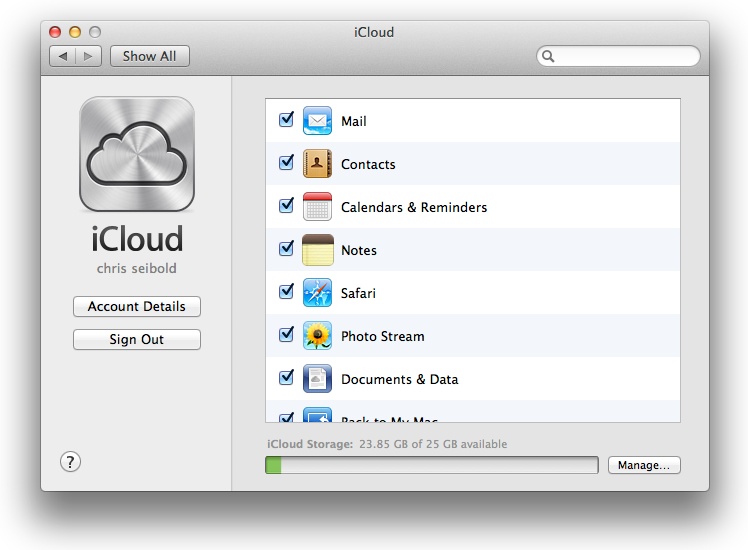
Figure 1-1. iCloud can sync a lot of apps out of the box, and more are on the
way!
You already know that you can share lots of things easily in
Mountain Lion, but just mentioning that feature in passing doesn’t do it
justice. You share things by clicking the new button found in many Apple
apps (see
Figure 1-2
).
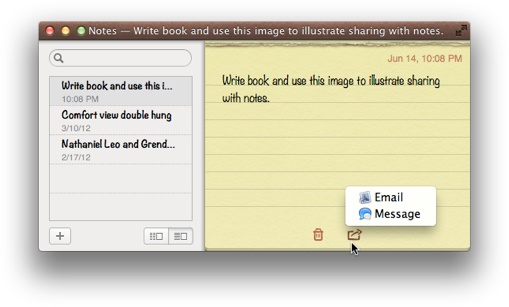
Figure 1-2. Sharing a note
Clicking that button invokes what Apple calls a Share
Sheet—a menu of all the ways you can share the thing you’re viewing. You
could, for example, share a web page via Twitter, send someone’s contact
info via email, or post a tweet. Exactly
how
you can
share the information depends on what app you’re using. With Contacts, you
can email, message, or AirDrop the card. With a web page, you get even
more choices, as
Figure 1-3
shows.
One of the options on Share Sheets is Twitter. In fact,
Twitter pops up in lots of the apps that come with Mountain Lion. That
makes it super easy to quickly post stuff on Twitter, but half the fun
of tweeting is the replies you get. So why would Apple include easy
access to Twitter without giving you an easy way to hear about replies?
It didn’t: Mountain Lion’s new Notification Center (described next)
takes care of that half of the Twitter experience.
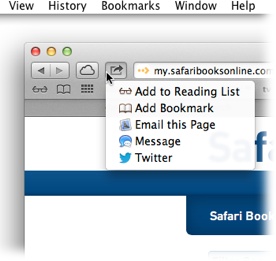
Figure 1-3. Options for sharing a web page
In earlier versions of OS X, notifications consisted of
badged icons (like the little red spot showing how many messages you
have in Mail) and notices that you couldn’t miss, like when your Mac
informed you that there were software updates available. But
notifications have gotten much better in Mountain Lion. With the
addition of Notification Center (
Figure 1-4
), you get to
control exactly which apps (or even which people) can notify you and
what kind of notifications you receive. That level of control wasn’t
available in earlier versions of OS X.
If you take a look at the desktop in Mountain Lion, you’ll notice
a Notification Center symbol in the upper-right corner (the icon is
supposed to look like a bulleted list). Clicking this symbol displays
your most recent notifications. And Mountain Lion doesn’t just stick to
the old-school notifications you’re used to: you’ll see notifications
from all kinds of apps, including Game Center, Safari, Messages, Mail,
FaceTime, and Calendar, among
others. Even Twitter comes along for the ride, and Twitter isn’t even an
app!
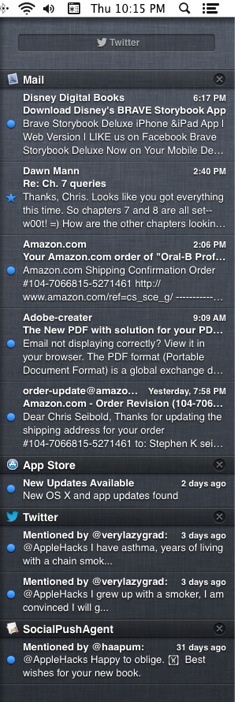
Figure 1-4. A central repository for all your notifications
But you don’t
have
to click that weird symbol
to see your notifications: Notification Center can let you see them as
they arrive, as shown in
Figure 1-5
.
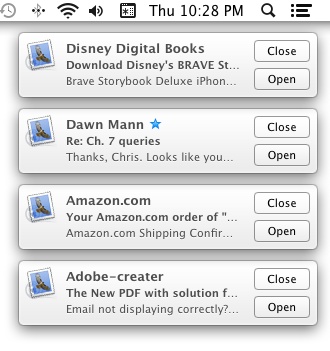
Figure 1-5. Banner-style notifications
If you’re worried that the notifications may be too intrusive or
annoying, relax. A trip to the Notifications preference pane lets you
control how you’re notified and which apps can notify you. See
Notifications
to learn how to fine-tune notifications.
One app whose notifications you’ll probably want to keep
turned on is Reminders (
Figure 1-6
). If you’ve used an
iOS device, Reminders is already familiar; if you haven’t, Reminders is
simply an app that lets you set up a list of things to do. The list is
then shared over iCloud so you can be reminded to go to that doctor’s
appointment or buy milk no matter whether you’re sitting in front of
your Mac or out running errands with your iPhone.

Figure 1-6. Reminders are finally on all your Apple devices
If you like the location-based Reminders on your iPhone (like
the “put on mask” reminder that pops up when you’re outside the bank),
you’ll be happy to learn that you can use location-based reminders
with Mountain Lion as well. See
Reminders
for
the details.
Notes is another app that started life in iOS and now
shows up in Mountain Lion (
Figure 1-7
). Like the other apps brought
over from iOS, Notes shares and syncs over iCloud: Write a note on your
Mac, and it shows up on your iPad. You can create notes that include
text, videos, and photos. For more info, see
Notes
.
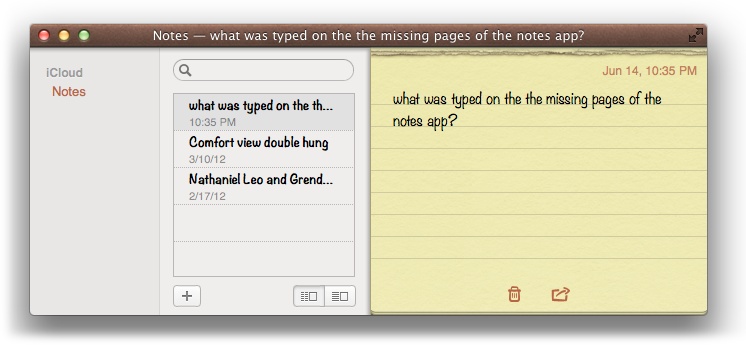
Figure 1-7. Notes is finally on your Mac
If you’ve used previous versions of OS X, you’re
undoubtedly well acquainted with the Software Update item in the Apple
menu. Selecting it used to bring up a maddeningly slow blue bar of
progress while your computer checked to see what updates were available.
Once that process finished, your Mac would either tell you everything
was up to date or, more likely, that there was a new version of iTunes
available, or was an update for iPhoto with enhanced support for RAW
images for some obscure camera model.
Happily, those days are over. When you select the Software
Update option in Mountain Lion, the App Store launches. The process is
now faster,
and
you can see just which apps need
updating without having to click Show Details (see
Figure 1-8
). Any software that you’ve purchased through
the App Store will get updated, not just apps published by
Apple.
Gatekeeper—which is part of the Security & Privacy
preference pane (
Figure 1-9
)—is Apple’s
effort to minimize the chances of malware (malicious software) showing
up on your Mac. Gatekeeper lets you decide, ahead of time, what apps you
can install based on where you got them from (though, if you have
administrator privileges, you can override this setting on a
case-by-case basis by Control-clicking the app’s icon and choosing Open
from the pop-up menu.
To learn how to set up Gatekeeper, see
Security & Privacy
.
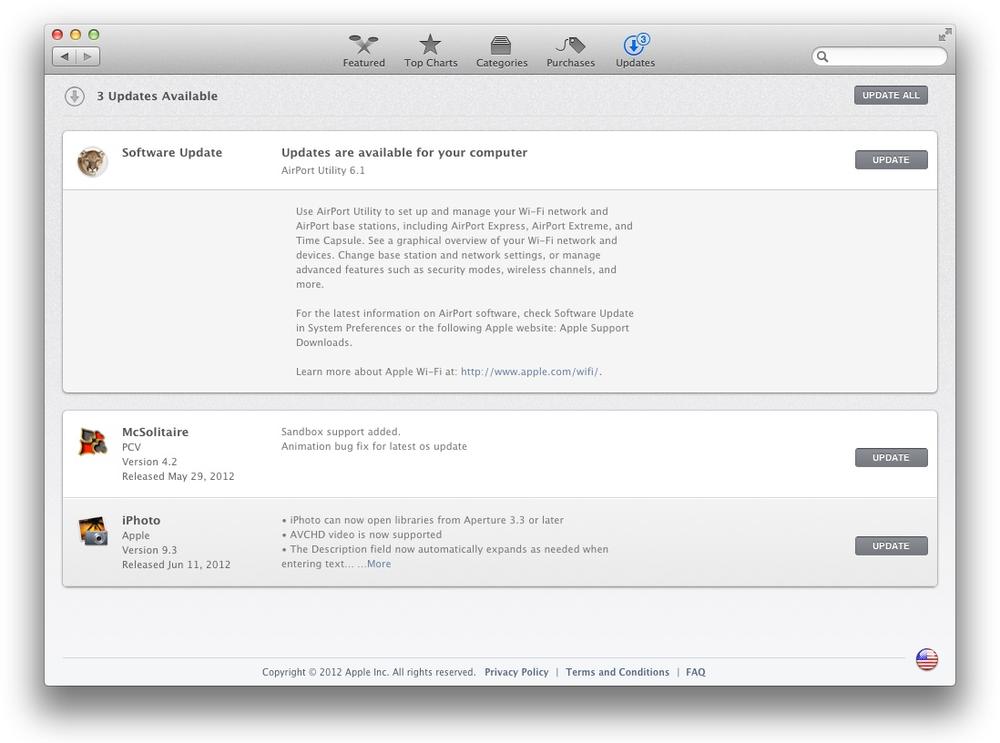
Figure 1-8. Updating apps
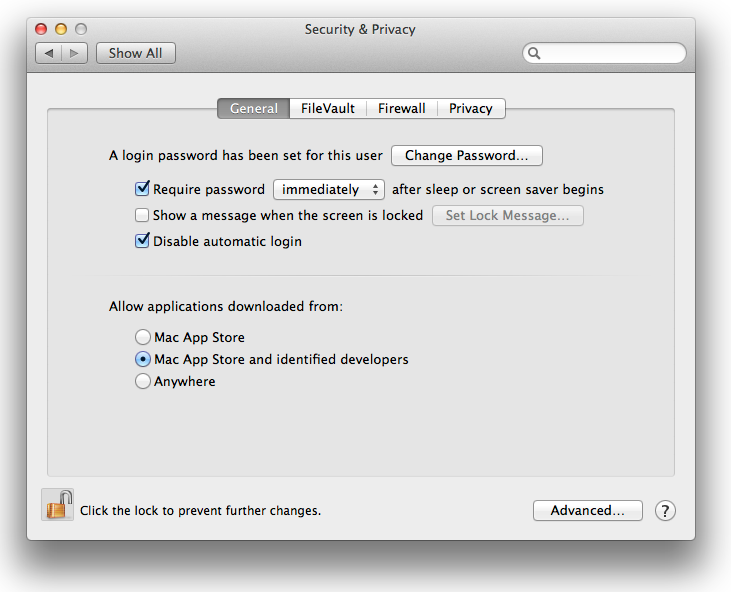
Figure 1-9. Setting up Gatekeeper